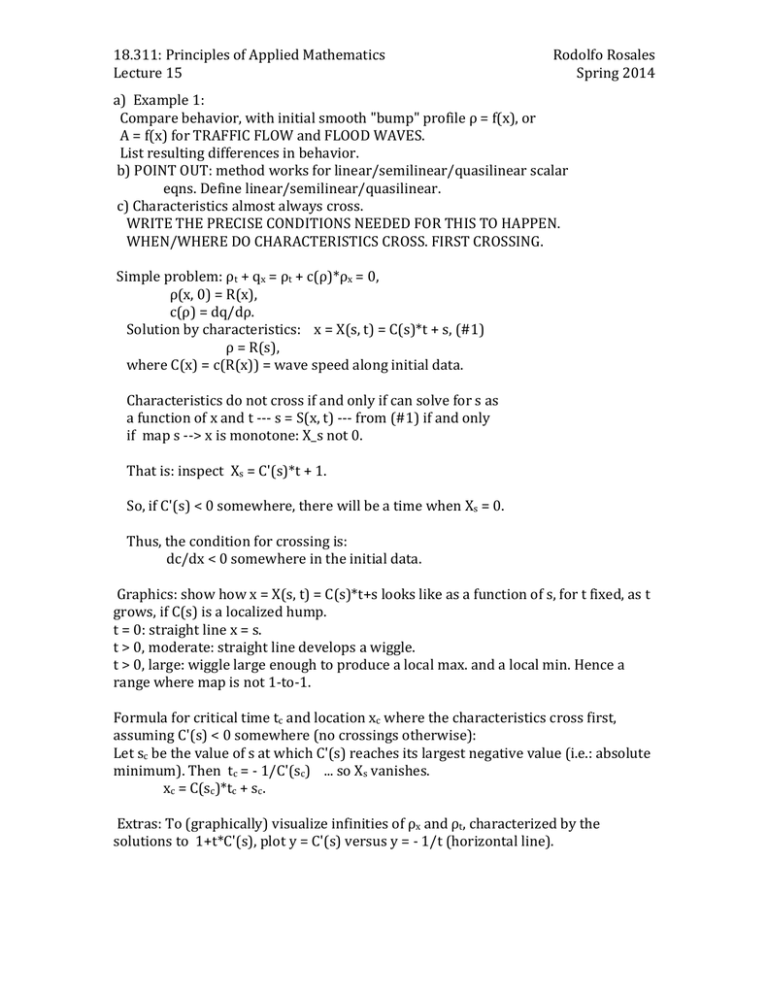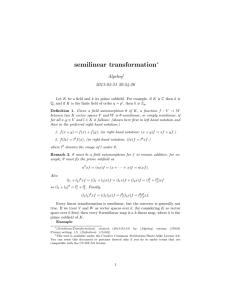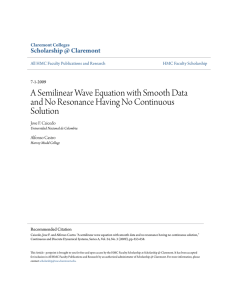Document 13570574
advertisement

18.311: Principles of Applied Mathematics Lecture 15 Rodolfo Rosales Spring 2014 a) Example 1: Compare behavior, with initial smooth "bump" profile ρ = f(x), or A = f(x) for TRAFFIC FLOW and FLOOD WAVES. List resulting differences in behavior. b) POINT OUT: method works for linear/semilinear/quasilinear scalar eqns. Define linear/semilinear/quasilinear. c) Characteristics almost always cross. WRITE THE PRECISE CONDITIONS NEEDED FOR THIS TO HAPPEN. WHEN/WHERE DO CHARACTERISTICS CROSS. FIRST CROSSING. Simple problem: ρt + qx = ρt + c(ρ)*ρx = 0, ρ(x, 0) = R(x), c(ρ) = dq/dρ. Solution by characteristics: x = X(s, t) = C(s)*t + s, (#1) ρ = R(s), where C(x) = c(R(x)) = wave speed along initial data. Characteristics do not cross if and only if can solve for s as a function of x and t -­‐-­‐-­‐ s = S(x, t) -­‐-­‐-­‐ from (#1) if and only if map s -­‐-­‐> x is monotone: X_s not 0. That is: inspect Xs = C'(s)*t + 1. So, if C'(s) < 0 somewhere, there will be a time when Xs = 0. Thus, the condition for crossing is: dc/dx < 0 somewhere in the initial data. Graphics: show how x = X(s, t) = C(s)*t+s looks like as a function of s, for t fixed, as t grows, if C(s) is a localized hump. t = 0: straight line x = s. t > 0, moderate: straight line develops a wiggle. t > 0, large: wiggle large enough to produce a local max. and a local min. Hence a range where map is not 1-­‐to-­‐1. Formula for critical time tc and location xc where the characteristics cross first, assuming C'(s) < 0 somewhere (no crossings otherwise): Let sc be the value of s at which C'(s) reaches its largest negative value (i.e.: absolute minimum). Then tc = -­‐ 1/C'(sc) ... so Xs vanishes. xc = C(sc)*tc + sc. Extras: To (graphically) visualize infinities of ρx and ρt, characterized by the solutions to 1+t*C'(s), plot y = C'(s) versus y = -­‐ 1/t (horizontal line). MIT OpenCourseWare http://ocw.mit.edu 18.311 Principles of Applied Mathematics Spring 2014 For information about citing these materials or our Terms of Use, visit: http://ocw.mit.edu/terms.



